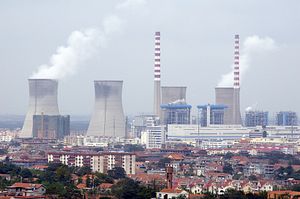Get ready for China’s nuclear industry to boom (no pun intended): The China Nuclear Energy Association (CNEA) predicts that eight new nuclear reactors will begin operation this year. If so, that will mark the largest single-year increase in nuclear power production in China’s history.
China is looking to more than double the number of nuclear power plants in operation — there are currently 23 operating, with 26 under construction. If all the projects are completed as planned, it would bring China’s nuclear energy capacity up to 49.9 gigawatts, compared to the current capacity of 21.4 gigawatts. Plus, CNEA expects an additional six to eight nuclear energy projects to be approved this year.
Zhang Huazhu, the chairman of CNEA, called 2015 “an important yet for China to resume its nuclear power program.” Like many countries, China slammed the brakes on nuclear power after the Fukushima disaster in Japan; the industry in China is just beginning to regain its footing. A rapid expansion of nuclear power is critical for weaning China off of coal and reaching emissions reduction targets, but safety concerns (and public fears) continue to plague the industry. In 2014, China didn’t approve a single new nuclear power project, and investment in the industry dropped by 6.6 percent, Zhang said, speaking an industry conference in Beijing.
Currently, nuclear energy accounts for less than 3 percent of China’s total power generation. “In the coming decade, China will maintain a rapid pace of nuclear power development so that it can reach the target of nuclear installations by 2020 and make better use of energy,” Zhang said. China’s stated goal is to have 58 gigawatts in nuclear power capacity by 2020, but that goal may be difficult to reach given the slowdown in construction after 2011.
Part of the problem is that China has pledged to only approve new third-generation reactors but that technology is largely untested, according to Reuters. China’s own indigenously-developed third-generation reactor, the Hualong-1 (developed by China National Nuclear Corp and China General Nuclear Power Group), was just approved for use by China’s State Council on April 15. The newly-approved Fuqing nuclear power project in the eastern province of Fujian will be the first to make use of Hualong-1. Industry insiders expect a second Hualong-1 project, the Fangchenggang nuclear power plant in Guangxi province, to be approved next.
China is also hoping to export the Hualong-1, part of its plan to become a world leader in the nuclear power industry by 2020. A joint Chinese-Pakistani nuclear power project in Karachi could see the first use of Hualong-1 outside of China. Zhang said China is also negotiating the construction of a Hualong-1 reactor in Argentina.

































